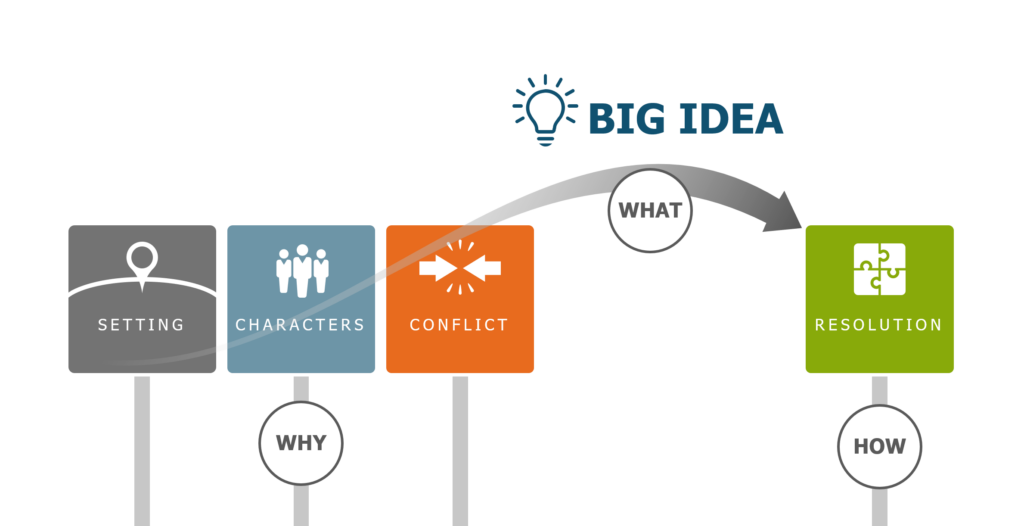Executive presence… you’ve either got it or you don’t, right? …we beg to differ.
Whether you are a data guru or a budding manager, anyone can “own the room”, navigate difficult questions, and come across authentically during a presentation… with the right tools. And it doesn’t involve wearing power suits or adopting a certain swagger. This is about something entirely different – the power of storytelling.
The magic happens when you apply a business storytelling framework to anything you present. A story framework helps you choreograph your facts, data, insights, and recommendations in a way that prevents the worst presentation plagues – derailment, confusion, or even boredom. Why so? Because story arcs are so familiar to us, they offer both the presenter and the audience a constant guideline of where the narrative is going and where it’s been. The result is that presenters are in the driver’s seat throughout their presentation, which in turn, does wonders for their confidence.
Prepared + Relaxed = Authoritative
So why stories? Because our brains are wired to tell (and respond) to stories. Neuroscience has shown that stories create an emotional response to what we present. We describe a conflict, people and places affected by that conflict, and our audience will automatically crave a resolution. Setting the stage this way early on establishes authority and trust from the beginning.
A common example is the novice salesperson. She might be so eager to jump into the features or function of her product (we call this the resolution) that she skips the crucial step in establishing this trust and authority. She has not given her audience a reason to care. With a storytelling mindset, she won’t fall to pieces when the CEO asks her to pivot back and forth to answer impulsive questions. She won’t panic when her pitch is cut from 30 minutes to 5 (sound familiar?). She won’t see stone-faces or confusion when she faces multiple executives, from different departments, who each have varying objectives. Her story structure lets her ‘zig’ and ‘zag’ through the material, calmly addressing everyone’s needs as it comes.
She’s now able to maintain a controlled dialogue with her audience from start to finish. She is believable, authentic, and relatable.
A Primer: The Why, The What, and the How of Storytelling
The story structure is comprised of a basic arc: setting, characters, conflict, and resolution. Carefully strung through each of these signposts is a single BIG idea. It’s the key, strategic insight of your presentation. In other words it’s the WHAT of your presentation.

This concept must be supported by every fact or piece of data you present.
Setting, character and conflict are the WHY of your story. Who is affected by your presented facts? In what context does it matter? This establishes a reason for your audience to care about what you eventually will offer – the resolution. Your resolution is the HOW of your story and it must come last. How will your product features/solution/program recommendations resolve the issues that are laid down?
As mentioned above in the salesperson example, we often make the mistake of focusing most of our energy on the HOW of our ideas before we establish the WHY. And it’s the ultimate rookie move.
Audiences start to squirm in their seats, check their phones, or interrupt your session when they don’t know why they should care about your ideas. This of course, makes inexperienced presenters visibly nervous, which in turns saps their believability and authority. Game over.
The best storytellers focus on the WHY and WHAT first…then they share the HOW. It’s also important to note that in a situation where your time is suddenly crunched, your WHY and your WHAT don’t have to take up a lot of time. This could be established in 60 seconds with three quick slides to open your presentation, or verbally with no slides at all. After that, you can quickly move to your HOW.
Chapter Headings Follow A Story Progressing
Stories are helped immeasurably when the key point of every slide is made into a headline. This dynamite storytelling technique will automatically progress your narrative through these “chapter” headings, offering everyone a cue to where you are going and keep your confidence on track!

As you can see above, the slide on the left offers a generic heading that doesn’t clearly further the narrative. The headline on the right moves the narrative forward with a decisive fact, using a callout to tell the audience what you want them to know about the data.
Executive Presence is a Career Game-Changer

Storytelling helps people structure memorable, persuasive presentations. But a powerful byproduct of learning story structure is that it makes us demonstrably more confident, authoritative presenters. The Center for Talent Innovation finds that executive presence accounts for 26 percent of what it takes to get your next promotion. What’s more, storytelling structure doesn’t just apply to presentations. It’s a communication technique that applies to emails, virtual meetings, handouts, even voicemails. No matter where or who you are presenting to, a clear roadmap to help you navigate flexibly through your material will help you stay calm, responsive, and confident.
Want to up-level your executive presence and stand out from the competition? Learn more about our business storytelling workshops here.
